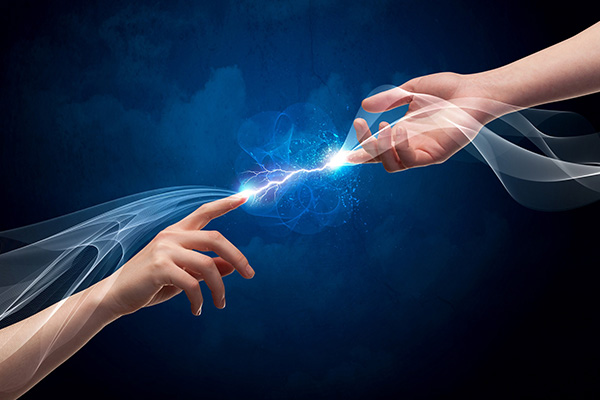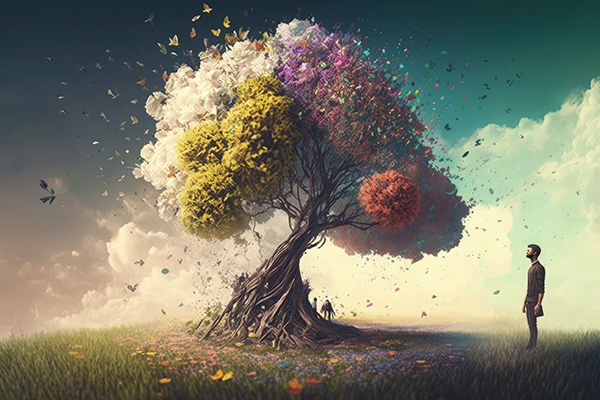How to Replace Nighttime Overthinking with Morning Clarity
 As the evening descends and the surroundings grow calm, our thoughts tend to do the opposite. Numerous individuals get trapped in a never-ending cycle of excessive contemplation as they revisit past events and fret about what lies ahead. This intense mental turbulence of anxiety can lead us to feel mentally cloudy and drained emotionally, far from our genuine state.
As the evening descends and the surroundings grow calm, our thoughts tend to do the opposite. Numerous individuals get trapped in a never-ending cycle of excessive contemplation as they revisit past events and fret about what lies ahead. This intense mental turbulence of anxiety can lead us to feel mentally cloudy and drained emotionally, far from our genuine state.
In the midst of chaos, there is a chance to experience personal development and empowerment. How can this be achieved? The answer lies in developing a deeper understanding of our intuition and improving our mental clarity, which will help us break free from the cycle of negativity and align with our true potential.
Many of us experience the common issue of excessive thinking during nighttime. When everything is quiet and our minds have been on autopilot throughout the day, it becomes a fertile ground for concerns, apprehension, and remorse. This eventually creates a harmful pattern of anxiety and sleeplessness, resulting in increased stress the following day. Consequently, this heightened stress fuels further anxiety and insomnia during subsequent nights, continuing the cycle.
Not only do we experience constant fatigue and lack of energy, but we also become detached from our true selves and our purpose in life. This energetic depletion and disconnection lead to doubt and uncertainty about our decisions and path, resulting in heightened anxiety and diminished self-worth. This harmful cycle greatly impacts our overall well-being, affecting us physically, mentally, emotionally, and spiritually.
Upon waking up, ponder upon the valuable privilege of being alive – the ability to breathe, to contemplate, to experience joy, and to love. ~ Marcus Aurelius
Intuitive Awareness
Our intuition is an innate ability that transcends rational thought. Our higher selves, spirit guides, angels and the Divine communicate with us through our intuitive awareness. It’s the inner voice of our soul that guides us to our true path. Unfortunately, this voice is often drowned out by the noise of daily life.
When we develop a deeper sense of intuition, we are able to discern our genuine wants and fears, distinct from the everyday conflicts and external influences. By aligning ourselves with our soul or higher self, we gain insight into our genuine requirements, desires, and purpose, which serves as a guiding light through the confusion of excessive thinking and doubt. This leads us towards a path that reflects our true essence, offering a sense of security and confidence with the assistance of Spirit and the Divine.
Mental Clarity
In order to improve our decision-making and stay aligned with our intuition, it is important to have a focused and clear mind. This means organizing our thoughts, ideas, and plans while avoiding unnecessary worries, regrets, and fears. By attaining mental clarity, we can approach daily problems and challenges in a calm and composed manner, making it simpler to find solutions, make smart choices, and have peaceful sleep at night.
To minimize nighttime anxiety, worry, and stress, it is essential to enhance our intuitive consciousness and mental clarity throughout the day. This will enable us to remain focused and reduce our concerns at night, ultimately breaking the cycle of insomnia.
Incorporating self-care and spiritual practices at the beginning of your day can greatly affect your overall well-being and productivity. Establishing certain habits in the morning can assist you in connecting with your inner guidance and maintaining a clear and focused mindset.
Having the correct morning routine can assist in eliminating harmful and destructive habits, as well as ensuring that you start your day with the necessary energy and positive mindset to make a meaningful contribution to your life. It enables you to have a productive and gratifying day, reducing your concerns and anxieties at night.
Morning is God’s way of saying one more time, ‘Go make a difference, touch a heart, encourage a mind, inspire a soul, and enjoy the day’ ~ Mufti Menk
Some suggestions for beginning your day with increased intuitive awareness and mental clarity are:
Meditation & Breathwork
Meditation calms the mind, reduces stress, and increases self-awareness, making it easier to connect with your intuitive self. Breathwork helps regulate the body’s stress response and can improve focus and clarity.
Start your day by dedicating at least 5-10 minutes to breathwork or meditation. Concentrate on your breath or utilize a guided meditation specifically crafted to heighten your intuition. Integrate deep breathing techniques to provide oxygen to your brain and body, consequently getting ready for the upcoming day.
Nature Meditation
Engaging with the natural world, whether by spending time outdoors or simply taking a quick break outside, has the power to greatly enhance your emotions, decrease stress levels, and enhance brain function. Being in natural surroundings helps keep us centered and fosters a deeper understanding of ourselves.
Drink your morning coffee outside, take a short walk in a nearby park, or simply stand on your balcony and watch the sky. The key is to be present and absorb the calming effects of the natural world.
Mindful Movement
Add a brief morning workout of yoga, stretching, or tai chi to your routine. Pay attention to how your body feels and your breath flows. Engaging in gentle physical activity like yoga, tai chi, or stretching in the morning enhances blood circulation to the brain, boosts mental clarity, and aids in connecting with your body’s instincts. Mindful exercises also aid in relieving physical stress that may impact your thought process.
Journaling
Morning journaling can help you capture your first thoughts of the day, which are often closer to your subconscious. This practice can reveal intuitive insights and help clear mental clutter by organizing your thoughts.
Keep a journal by your bed and write for a few minutes each morning. You can record dreams, list things you’re grateful for, set intentions for the day, or write down any thoughts or feelings that come up. You can also ask yourself these important questions and meditate on them:
In which areas do I experience the least movement of energy? In which areas do I experience the most vibrant energy flow?
Have I fulfilled my life’s purpose?
3. Am I hindering my life’s purpose? Am I permitting anger or a lack of empathy, maybe thoughtless remarks, to influence my behavior and speech?
What am I evading in my life? What is the essential issue I need to confront in order to progress and lead a fulfilling life?
What objectives do I have for today and tomorrow?
What possessions am I keeping that are no longer necessary? What can I give away or donate in order to feel more relaxed and liberated?
How can I achieve a state of calmness and cultivate a greater sense of inner peace?
Am I getting sufficient sleep? If not, I will make sure to consider these factors in order to improve my sleep habits.
Which individuals in my life should I detach myself from? Sever connections with anyone or anything that is burdening you.
Am I fully present in the present moment or am I preoccupied with thoughts of the future? If the latter is true, I will release those thoughts and direct my attention solely to the present, embracing each moment as it comes.
Taking some time to go over these questions, whether individually or as a group, can be a beneficial way to refresh your thoughts and begin your day with a clear mind.
Intention Setting
Setting intentions in the morning helps to guide your actions throughout the day, aligning them with your inner values and goals. This practice helps maintain focus and clarity, reduces decision fatigue, and increases intuitive decision-making.
After completing your morning meditation or journaling session, take some time to ponder what you aim to achieve or the emotions you desire to experience throughout the day. Establish one to three concise objectives.
Lifestyle Habits
Eating a well-balanced diet gives your brain the necessary fuel for optimal functioning, whereas maintaining sufficient hydration prevents tiredness and enhances mental sharpness. Start your day with a healthy and nutritious breakfast, accompanied by a glass of water. Remember to stay hydrated consistently throughout the day.
Start the day with a digital detox. Delaying morning email and social media check-ins can prevent the immediate stress response and cognitive overload, allowing you to begin your day with a clearer, more intuitive mindset. Set a specific time to start checking your phone or computer, and at least the first hour or two of your day will be free of digital input and toxic trolls.
By incorporating these activities into your morning routine, you establish a strong sense of intuition and clear thinking, which will assist you in effortlessly dealing with the challenges of everyday life. Explore different spiritual practices and lifestyle habits to discover what aligns with you and seamlessly fits into your mornings. Witness the amazing transformation these practices have on your daily life: smoother days, a greater sense of purpose, and a peaceful night’s sleep. It is your inherent right to live a content and fulfilling life.
|
Moon Goddess is a third-generation empathic healer and seer who began offering healing readings to individuals over 20 years ago. Since a young age, she has had a strong interest in and studied various metaphysical subjects. Due to her heightened sensitivity, she can perceive and foresee events before they occur. By utilizing the Tarot and relying on her Guides, she provides support to numerous individuals worldwide. Following her grandfather’s passing, he fulfilled his promise by returning to bid her farewell and granting her an incredible experience. This encounter affirmed Moon’s belief in the existence of a heavenly realm that is truly magnificent. Sharing her own encounter has proven valuable to those who are grieving the loss of a loved one or experiencing any kind of sorrow. Receive a reading with Moon Goddess now through PsychicAccess.com. |
How to Replace Nighttime Overthinking with Morning Clarity
Do you often find yourself struggling to fall asleep because your mind is filled with thoughts and worries? If this sounds familiar, you’re not alone. Many people experience nighttime overthinking, which can lead to restless nights and groggy mornings. However, there are steps you can take to replace nighttime overthinking with a clear and focused mindset in the morning. In this article, we will explore effective strategies to help you achieve a more peaceful and productive sleep.
1. Create a consistent bedtime routine: Establishing a regular routine before bed can signal to your body that it’s time to wind down and prepare for sleep. Engage in relaxing activities such as reading, taking a warm bath, or practicing meditation. Avoid stimulating activities like watching TV or using electronic devices, as they can interfere with your ability to fall asleep.
2. Practice mindfulness: Mindfulness involves being fully present in the moment without judgment. By focusing on the present rather than dwelling on the past or worrying about the future, you can reduce nighttime overthinking. Try incorporating mindfulness techniques into your daily routine, such as deep breathing exercises or guided meditation, to cultivate a calmer mind.
3. Write in a journal before bed: Putting your thoughts and worries down on paper can help release them from your mind. Journaling allows you to externalize your concerns and gain perspective on them. By acknowledging and addressing your worries in writing, you can prevent them from spiraling into nighttime overthinking.
4. Designate a worry period: Instead of allowing your mind to wander freely at night, set aside a specific time during the day to focus on your concerns. Dedicate 15-30 minutes to actively think about and address these worries. By confining your worries to this designated time, you can prevent them from intruding on your sleep and have a more restful night.
5. Challenge negative thoughts: Nighttime overthinking often involves negative thoughts and self-criticism. Learn to identify and challenge these negative thoughts by asking yourself if they are based on evidence or if there might be alternative explanations. Replace negative thoughts with more positive and realistic ones. This cognitive restructuring can help alleviate anxiety and promote a more peaceful mindset.
6. Make a to-do list: Sometimes, overthinking at night arises from a fear of forgetting important tasks or responsibilities. To ease this worry, create a to-do list before bed. Write down all the tasks you need to accomplish the next day, allowing your mind to rest knowing that you won’t forget anything important.
7. Incorporate relaxation techniques: Include relaxation techniques in your nighttime routine to promote a calm and restful sleep. Deep breathing exercises, progressive muscle relaxation, or listening to soothing music can help relax your body and mind, making it easier to let go of overthinking and fall asleep.
8. Limit caffeine and alcohol intake: Both caffeine and alcohol can disrupt your sleep patterns and contribute to nighttime overthinking. Limit your consumption of these substances, especially in the evening, to ensure a more restful sleep.
9. Create a sleep-friendly environment: Transform your bedroom into a peaceful haven for sleep by creating a comfortable environment. Keep the room cool, dark, and quiet. Invest in a supportive mattress and pillows, use blackout curtains or an eye mask, and consider using white noise machines or earplugs to block out any disturbing sounds.
10. Seek professional help if needed: If nighttime overthinking persists despite your best efforts, seeking professional help may be beneficial. A therapist or counselor can offer guidance and support in managing anxiety and overthinking, and help you develop effective coping strategies based on your unique needs.
By implementing these strategies, you can replace nighttime overthinking with morning clarity. Remember, changing deep-rooted thought patterns takes time and practice, so be patient with yourself. With persistence and a commitment to self-care, you can enjoy more restful nights and wake up with a clear and focused mind ready to take on the day.
















